|
Work progress 0.9.7.1
|
|
| neutronium76 | Date: Monday, 11.11.2013, 11:25 | Message # 361 |
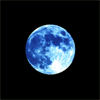 World Builder
Group: Users
 Greece
Greece
Messages: 718
Status: Offline
| Quote HarbingerDawn (  ) Currently there is no system by which procedural object names can be localized in any way, and I don't know how much work would be required to implement that. That's what I meant.
Ah sorry I thought you meant that it would be hard to localize because it would be confusing. I should have stated that it wouldn't have been confusing had a naming system including letters been implemented already.
PC1:Core i7 970@3.34GHz, 6 cores/12 threads, 12GB DDR3 RAM@1.34GHz, 2x(SLI) GTX-580 GPUs 3GB VRAM(GDDR5)@1GHz, OS:Win7x64SP1
PC2:Core2Quad X9770@3.2GHz, 2 cores/4 threads 4GB DDR2 RAM@1GHz, GTX-285 GPU 1GB VRAM(DDR3)@1.24GHz, OS:WinVistax64SP2
|
| |
| |
| SpaceEngineer | Date: Monday, 11.11.2013, 11:58 | Message # 362 |
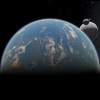 Author of Space Engine
Group: Administrators
 Russian Federation
Russian Federation
Messages: 4800
Status: Offline
| Quote neutronium76 (  ) Also something else that I just thought: Gas giants whose orbits are next or close to an asteroid belt (aka Jupiter-type) would probably have many satellites that will belong to all three groups. As we move closer to a star (i.e hot jupiters), the satellites would be fewer or even none (in case of very close proximity to the star). In Uranus, Neptune orbits, satellites would be a bit less than Jupiter region and will increase slightly/moderately again in Pluto, Oort cloud region if a frozen gas giant exists there. For ice giants, the algorithm should be modified to have a bit less satellites. I don't know if this would be easy to implement or if it is scientifically correct but I think it is logically correct.
All this work automatically taking into account proximity of a star and mass of a parent planet.
Quote Voekoevaka (  ) Cool idea ! I think letters "i", "r", and "o" could fit for inner, regular and outer.
So if I do this, I must do similar thing for dwarf planets. Especially if I implement procedural Kuiper belt - then any system would have hundreds of planets, 90% of which would be dwarf planets.

|
| |
| |
| SpaceEngineer | Date: Monday, 11.11.2013, 18:04 | Message # 363 |
 Author of Space Engine
Group: Administrators
 Russian Federation
Russian Federation
Messages: 4800
Status: Offline
| Implemented something like debris asteroid belt around a planet. Nothing new relative to engine, just few hundreds of asteroids orbiting a planet. Brute force implementation killed FPS immediately, so I made many optimizations: reduce size of asteroids to few kilometers (so only few models generated and rendered at once), disable lighting and casting shadows by asteroids on each other, make their orbits circular (so orbital motion computation is going as fast as possible). Anyway, FPS is just 30-40 if time is paused, and dropped twice if time is running (but this depend on planetary system - number of suns, asteroid belts, etc). However, lighting and shadowing is perfect:
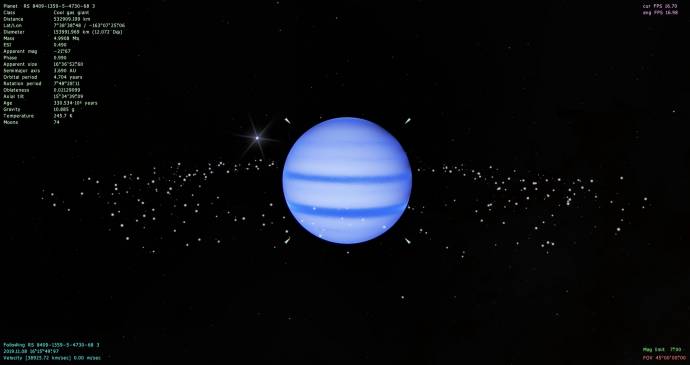
Debris is normal asteroids, so they rendered as asteroids with procedural landscape, and their orbits can be visualized as ususal:
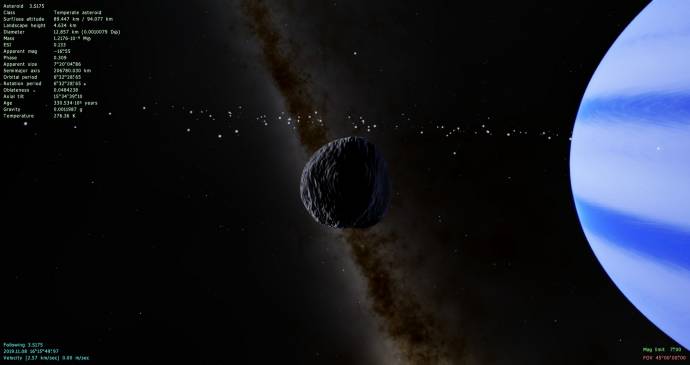
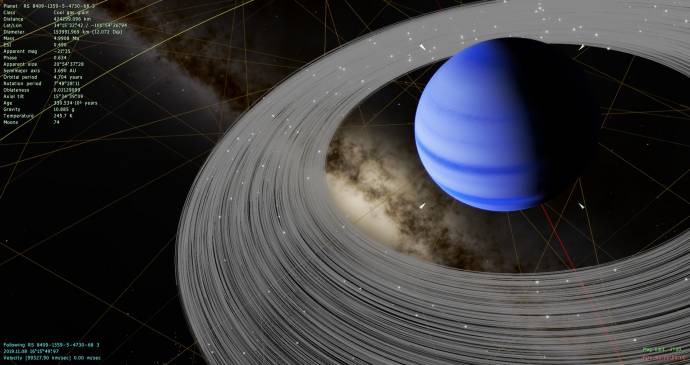
Computation of visual lighting/eclipsing and magnitude and color is done on CPU, and this is main bottleneck. Anyway even if it will compute on GPU, it will be possible to handle few millions of asteroids. So to implement good planetary rings with billions of debris, some cheats must be used.
From distance and planetary surface it looks a bit weird, due to very big visual magnitude of each debris (well, they are many kilometers in diameter, and this gas giant is close to sun), and pure white color.

Look how debris disappear when they go into gas giant shadow, and into satellite shadow. Second satellite casts its shadow above giant's equator, and debris do not enter it.

|
| |
| |
| neutronium76 | Date: Monday, 11.11.2013, 18:18 | Message # 364 |
 World Builder
Group: Users
 Greece
Greece
Messages: 718
Status: Offline
| OMG Space Engineer this is an oversaturation of new features! Slow down please - joking  . .
One piece of advice: Don;t try to fit so many things in this release because we all going to need new PCs 
Quote HarbingerDawn (  ) That doesn't make any sense; SE is developed for the same hardware requirements in every version, and will continue to be for a while. If you could run 0.90, then you'll be able to run 0.9.7.1.
Edit: I have a gut feeling that from this version the minimum and recommended hardware requirements will need to be raised. Anyway the above statement is partially meant to be a joke 
PC1:Core i7 970@3.34GHz, 6 cores/12 threads, 12GB DDR3 RAM@1.34GHz, 2x(SLI) GTX-580 GPUs 3GB VRAM(GDDR5)@1GHz, OS:Win7x64SP1
PC2:Core2Quad X9770@3.2GHz, 2 cores/4 threads 4GB DDR2 RAM@1GHz, GTX-285 GPU 1GB VRAM(DDR3)@1.24GHz, OS:WinVistax64SP2
Edited by neutronium76 - Monday, 11.11.2013, 18:36 |
| |
| |
| HarbingerDawn | Date: Monday, 11.11.2013, 18:25 | Message # 365 |
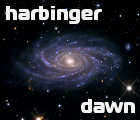 Cosmic Curator
Group: Administrators
 United States
United States
Messages: 8717
Status: Offline
| Quote neutronium76 (  ) One piece of advice: Don;t try to fit so many things in this release because we all going to need new PCs
That doesn't make any sense; SE is developed for the same hardware requirements in every version, and will continue to be for a while. If you could run 0.90, then you'll be able to run 0.9.7.1.
All forum users, please read this!
My SE mods and addons
Phenom II X6 1090T 3.2 GHz, 16 GB DDR3 RAM, GTX 970 3584 MB VRAM
|
| |
| |
| spacer | Date: Monday, 11.11.2013, 18:33 | Message # 366 |
 Star Engineer
Group: Users
 Israel
Israel
Messages: 1258
Status: Offline
| what is surf?
looks great!
"we began as wanderers, and we are wanderers still"
-carl sagan
-space engine photographer
Edited by spacer - Monday, 11.11.2013, 18:33 |
| |
| |
| HarbingerDawn | Date: Monday, 11.11.2013, 18:37 | Message # 367 |
 Cosmic Curator
Group: Administrators
 United States
United States
Messages: 8717
Status: Offline
| Quote spacer (  ) what is surf?
Surface
All forum users, please read this!
My SE mods and addons
Phenom II X6 1090T 3.2 GHz, 16 GB DDR3 RAM, GTX 970 3584 MB VRAM
|
| |
| |
| DeathStar | Date: Monday, 11.11.2013, 18:45 | Message # 368 |
|
Pioneer
Group: Users
 Croatia
Croatia
Messages: 515
Status: Offline
| Great! I am loving the additions to gas giant moons.
On a side note, this may sound stupid, but what exactly is the debris supposed to represent? Ruined moons?
|
| |
| |
| Tim | Date: Monday, 11.11.2013, 19:03 | Message # 369 |
 Explorer
Group: Users
 Belgium
Belgium
Messages: 296
Status: Offline
| Rings...
|
| |
| |
| JCandeias | Date: Monday, 11.11.2013, 19:19 | Message # 370 |
 Pioneer
Group: Translators
 Portugal
Portugal
Messages: 387
Status: Offline
| Quote neutronium76 (  ) Gas giants whose orbits are next or close to an asteroid belt (aka Jupiter-type) would probably have many satellites that will belong to all three groups. As we move closer to a star (i.e hot jupiters), the satellites would be fewer or even none (in case of very close proximity to the star). In Uranus, Neptune orbits, satellites would be a bit less than Jupiter region and will increase slightly/moderately again in Pluto, Oort cloud region if a frozen gas giant exists there.
For ice giants, the algorithm should be modified to have a bit less satellites.
The part about fewer satellites in close orbits is already implemented. Even my much less sophisticated systembuilding excel spreadsheet does that job perfectly. It's a consequence of the reduction of the size of spheres of influence as the planets get closer to their stars.
Regarding the rest, again, please don't take the Solar System as a model for everything. It is not a typical planetary system. In the real world, there are lots of different planetary arrangements, some of which are far less orderly than ours. And even if you do take our system as model, bear in mind one fact: the planets were not formed in their current positions. There were migrations in the earlier history of the system, some of which involving even swapping places.
What this means is that the only thing the proximity to an area rich in smaller bodies would possibly impact is the abundance of moons captured (sometimes much) more recently than the formation era, when both the planets themselves and their original satellites were formed. And even there, the impact would be smaller than one would think. Saturn, which is nowhere near the Asteroid Belt, has some 40 known irregular, outer, probably captured moons. Jupiter has some 50, which is no difference at all, considering that Jupiter is more massive and that the lower size limit of detected Jupiter moons lies at about 1 km, wereas that limit, for outer Saturn moons is in the range of 4 km.
As a comparison, for Uranus we're at some 20 km, and for Neptune at 40 km. There should be a lot more moons lurking undetected out there around the ice giants. And even the gas giants should have hundreds more rocks goung around them we know nothing about.
They let me use this!

|
| |
| |
| DeathStar | Date: Monday, 11.11.2013, 19:20 | Message # 371 |
|
Pioneer
Group: Users
 Croatia
Croatia
Messages: 515
Status: Offline
| Quote Tim (  ) Rings...
Well, rings are made of mostly dust a few centimeters in diameter, not asteroids
|
| |
| |
| JCandeias | Date: Monday, 11.11.2013, 19:24 | Message # 372 |
 Pioneer
Group: Translators
 Portugal
Portugal
Messages: 387
Status: Offline
| Quote DeathStar (  ) Well, rings are made of mostly dust a few centimeters in diameter, not asteroids
Ever heard of moonlets? No?
http://en.wikipedia.org/wiki/Moons_of_Saturn#Ring_moonlets
They let me use this!

|
| |
| |
| DeathStar | Date: Monday, 11.11.2013, 19:34 | Message # 373 |
|
Pioneer
Group: Users
 Croatia
Croatia
Messages: 515
Status: Offline
| I actually have, but thought they were an entirely different thing. Thanks for the info.
|
| |
| |
| SpaceEngineer | Date: Monday, 11.11.2013, 20:15 | Message # 374 |
 Author of Space Engine
Group: Administrators
 Russian Federation
Russian Federation
Messages: 4800
Status: Offline
| Quote JCandeias (  ) As a comparison, for Uranus we're at some 20 km, and for Neptune at 40 km. There should be a lot more moons lurking undetected out there around the ice giants. And even the gas giants should have hundreds more rocks goung around them we know nothing about.
So Uranus' and Neptune's systems actually may be similar to Jupiter's and Saturn's: a bunch of small inner moons, few major regular, and cloud of outer irregular. All 4 gas giants in our system shows the same architecture. So why do not take it as reference for all procedural systems? Such architecture appears in numerical simulations, and this is another good point for it. Only Triton disturbs the system, but it is classified as catastrophic capture event.

|
| |
| |
| Salvo | Date: Monday, 11.11.2013, 20:49 | Message # 375 |
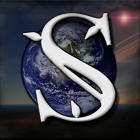 Star Engineer
Group: Local Moderators
 Italy
Italy
Messages: 1400
Status: Offline
| Quote werdnaforever (  ) I don't think the orbits themselves are a problem for the CPU
Yeah, of course, I was thinking about phisics, solar system browser and rendering near the planet 
Quote SpaceEngineer (  ) Implemented something like debris asteroid belt around a planet.
Aww 
The universe is not required to be in perfect harmony with human ambition.
CPU: Intel Core i7 4770 GPU: ASUS Radeon R9 270 RAM: 8 GBs
(still don't know why everyone is doing this...)
Edited by Salvo - Monday, 11.11.2013, 20:51 |
| |
| |